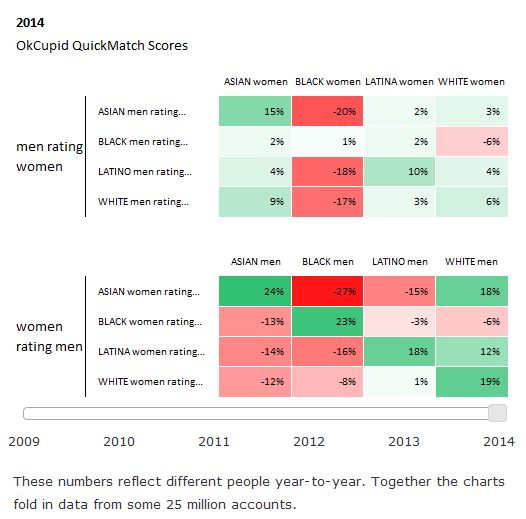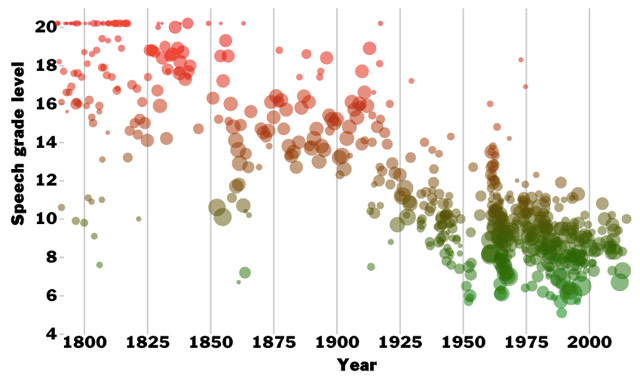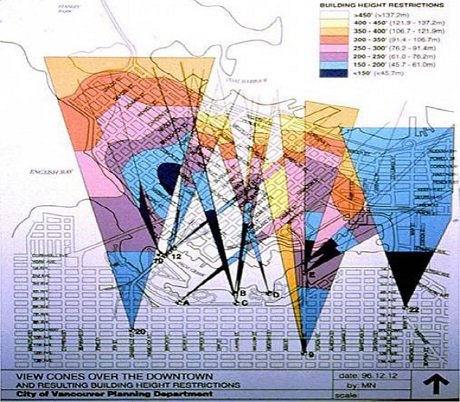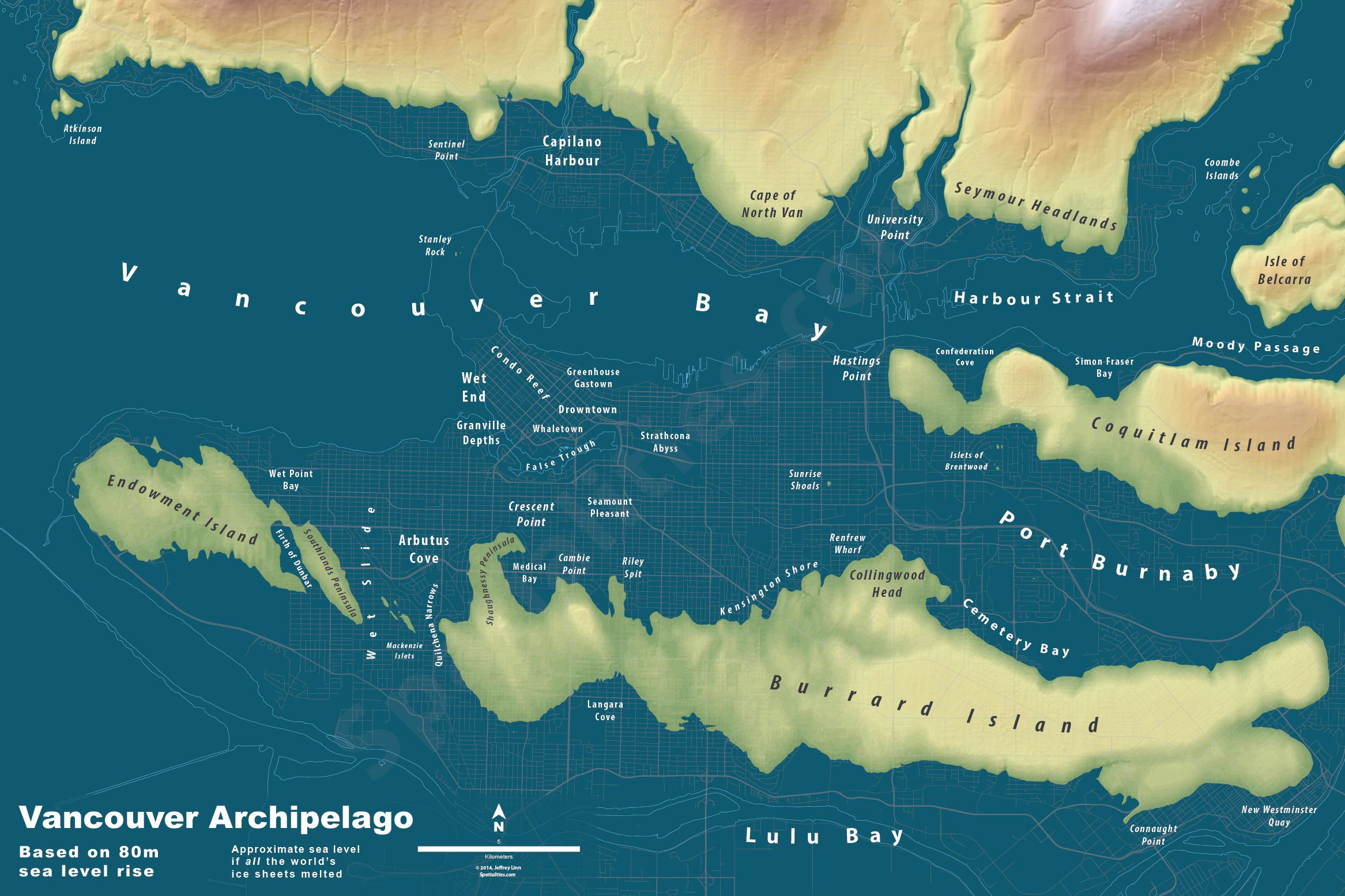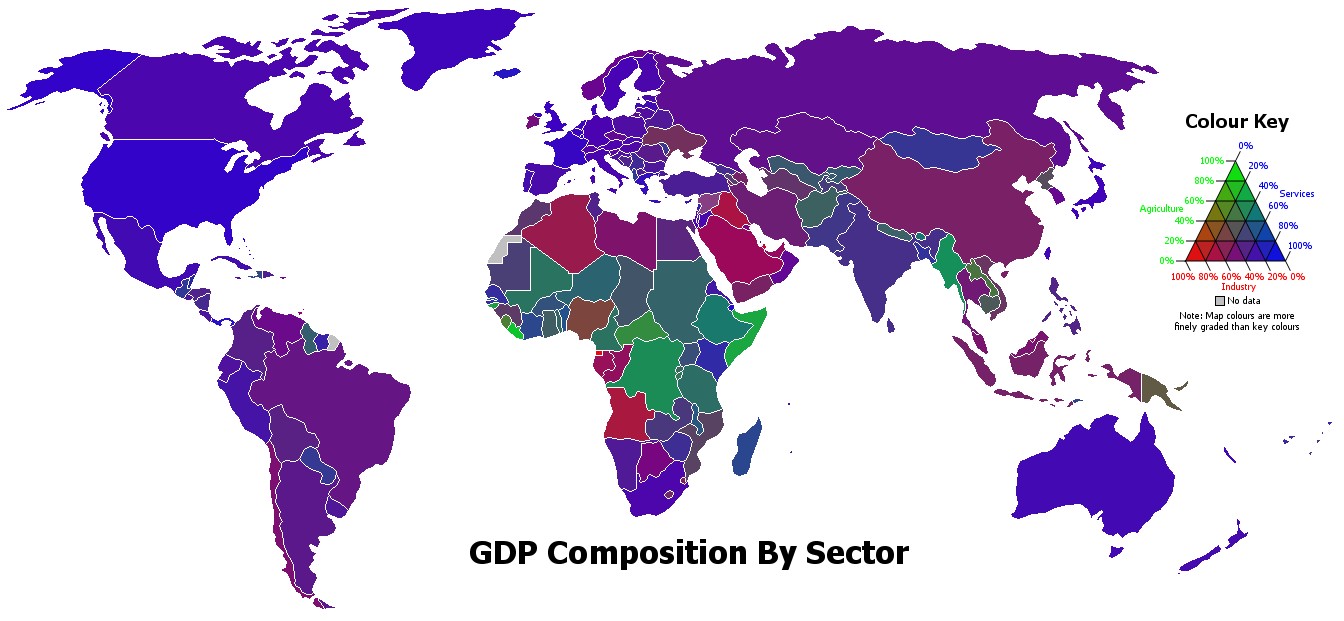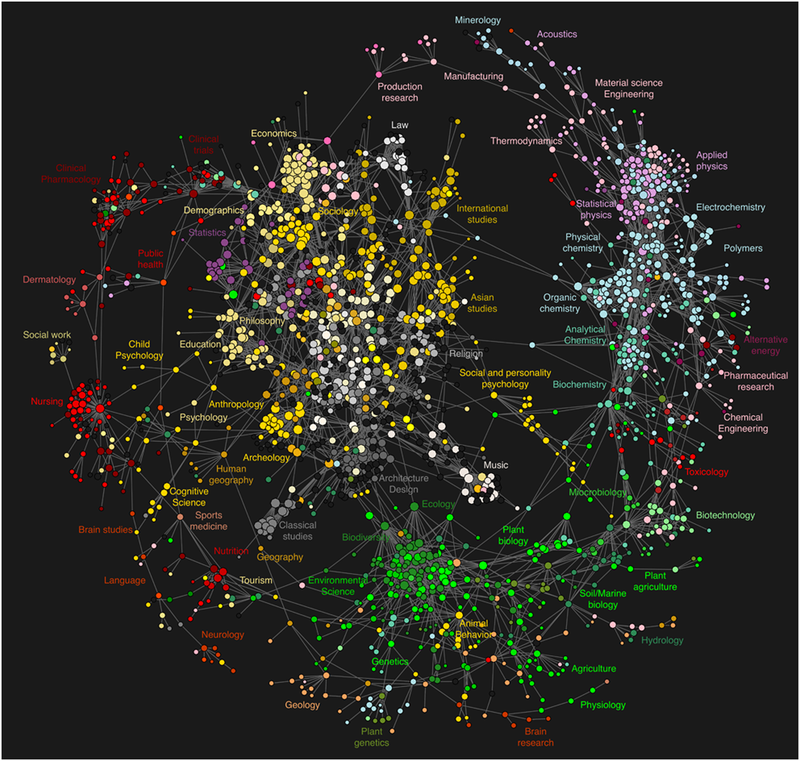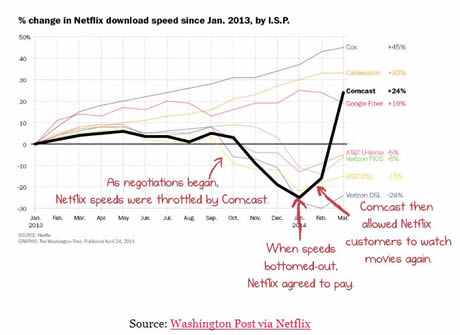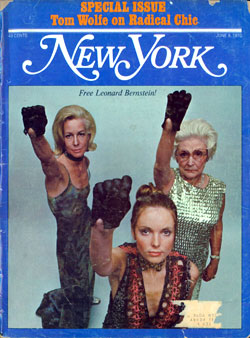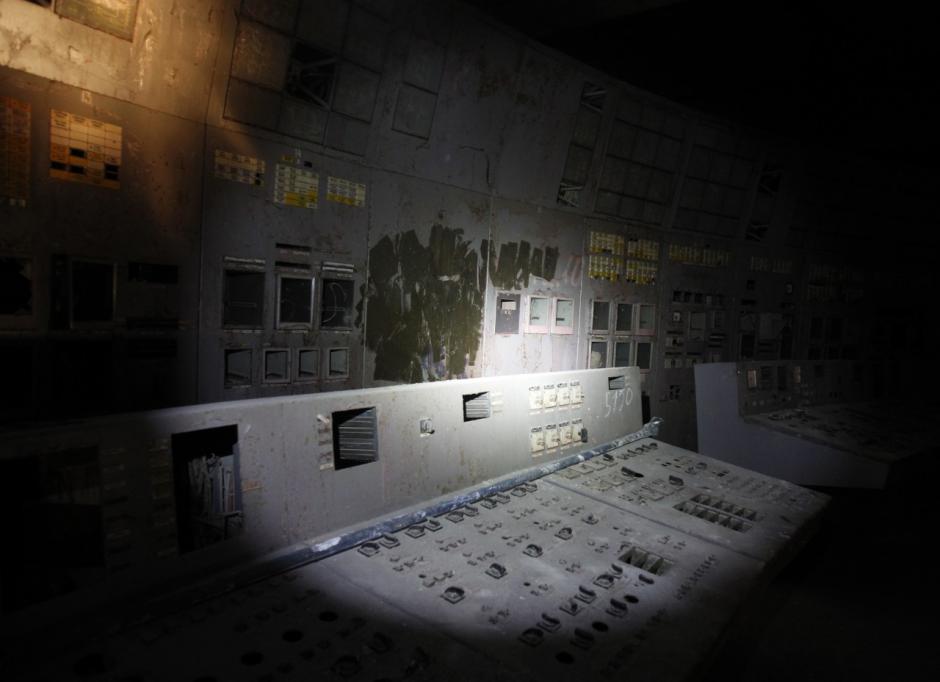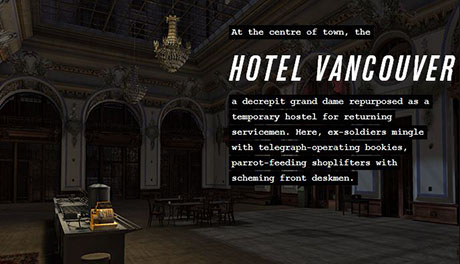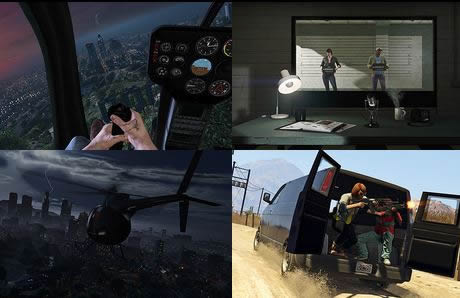december  2014
2014
2014 Best Infographics of the Year
1. OK Racists: Race and Attraction, 2009-2014
You may remember OK Trends, the statistical analysis wing of the popular dating site Ok Cupid, from such previous revelations as The Best Questions For A First Date and The REAL 'Stuff White People Like'. That was the one that broke down the most common unique phrases found in their user profiles by race and gender. They summed that one up nicely on the blog, saying, "If I had to choose over-arching themes for white people's lists, for men, I'd go with 'frat house' and for women, 'escapism.' Whether one begot the other is a question I'll leave to the reader."
This time they've analyzed their users' preferences over a five-year period and found that, while racial attitudes have grown more liberal over time, users' ratings of potential mates (e.g. white women rating white men, black men rating Asian women, etc.) show an increase in racial bias. Not only has the nearly universal preference (with a couple of significant exceptions) for one's own race slightly increased, but in most cases, users' ratings of other races have grown more negative (e.g. Asian women rated Black men 14% below average in 2009; by 2014 it was 27% below average). Black women fared even worse, with ratings far below average from every race except their own—and even their ratings from black men hovered around zero (average) or slightly negative until just this year when it hit +1 percent.
But that doesn't mean OK Cupid users are racists, they say, at least no more so than anybody else. Apparently we're all racists, but on dating sites like OK Cupid, you get to call it a "preference."
2. Vocativ's Timeline of Presidential Speech Readability
"Using the Flesch-Kincaid readability test—the most well-known reading comprehension algorithm—Vocativ analyzed over 600 presidential speeches, going back to George Washington."
Looking at this infographic, you might find yourself thinking: well, that just about says it all, and you'd be right. But that's not what its creators or its interpreters want you to think.
Jeff Shesol, former Clinton speechwriter explains how we should read the graph: "It's tempting to read this as a dumbing down of the bully pulpit, but it's actually a sign of democratization. In the early Republic, presidents could assume that they were speaking to audiences made up mostly of men like themselves: educated, civic-minded landowners. These, of course, were the only Americans with the right to vote. But over time, the franchise expanded and presidential appeals had to reach a broader audience."
So... according to the speechwriter, it's not the speeches that got dumber, it's the audience. See, in the time of Jefferson and Adams, Presidents could freely discuss "ideas" like slavery and taxes and who should be allowed to vote because their audience was made up of other white men (aka "educated, civic-minded landowners") who understood their, you know... ideas. Now that all the wimmin-folk and wetbacks and po' white trash are in the audience—and some of them can even read—well, this is why we can't have nice things.
Maybe what the speechwriter meant to say is that Presidential speeches should be judged not by the complexity of their syntax but by the content of their characters? It's tempting to assume that's what he meant, but it's hard to take anyone's argument about "democratization" seriously when he goes on to refer to the democratic system as a "franchise" in his very next breath. What could be sadder than a Democrat speechwriter who can't even sell his audience on their own intelligence? Where's Aaron Sorkin when you need him?
Then again, maybe the fault lies not in our stars but in our statistics. As one early commenter pointed out, "Modern readability tools are based on the frequency of words in the year the tool is created, not on frequency over time, so... The further in the past something has been written, the more likely the frequency of its lexicon has dropped, which is why old books and speeches are hard to understand."
You know your patriarchy is in trouble when the Internet commenters are smarter than the study that's trying to show them how dumb they've gotten. (Also worth mentioning is the post right below that: "I don't understand—this comment seems to make an intelligent point and take a nonpartisan view of the issue that has added something to my understanding of the original post. What's this doing on the internet?")
3. Vancouver View Cones
View cones, view corridors, protected views—whatever you want to call them, they're a big fucking deal in Vancouver city planning and real estate development circles. To get a taste for the debate, complete with illustrations like the one below (and proposed revisions to same), check out the Skyscraper page forum.
With less than 150 years under its belt and a population just over 600,000 in the city center, Vancouver is one of the most self-aware and purposeful cities on the planet when it comes to urban planning. Vancouver's "view cones" were adopted in 1989 (and reassessed in 2011) and they describe the direct line of sight from certain, often arbitrary, spots around the city radiating out at ground level in cone-shaped swaths. Within each of these cones, building heights and density are limited to certain specifications in order to preserve the visibility of the surrounding mountains.
The problem with limiting vertical growth in a city that's already bordered on three sides by water (not to mention those mountains), is that the only alternative to building up is building out, and the only buzzword more contentious than "density" in these circles is "sprawl." I'm squarely on the side of density, in case you have to ask. I say build them as high as your siesmic assessments and modern marvels of engineering will allow.
4. Vancouver (and other cities) + 30 meters sea level rise
That faint network of gridlines you can see there in the middle underwater? Yeah, that would be the entire lower mainland, an hour out from downtown in every direction.
5. GDP by sector
A world map that shows the concentration of national GDP from agriculture (green), industry (red) and services (blue). This looks kind of alarming, but it's probably fine, right? You can go nuts with Wikipedia's Economic maps of the world collection here.
6. Air Crash Casualties by Decade
2014 was the worst year for air crash casualties in almost a decade with 1,320, a hopefully temporary blip on a steady downward trajectory going back several years. The bar graphs below show that the trend had been accelerating since 2000, and how we just dipped below 1,000 three years in a row. In 2013 there were fewer than 500 flight-related deaths for the first time since the 1930s. So, yes... I have a site called Bureau of Aircraft Accidents Archives bookmarked but I'm not trolling for tragedy. I'm there to scavenge for good news and I swear I've never clicked the link for "crash pictures" (although, that's not to say doing so would make you a bad person).
Air Crash Casualties 2000-2009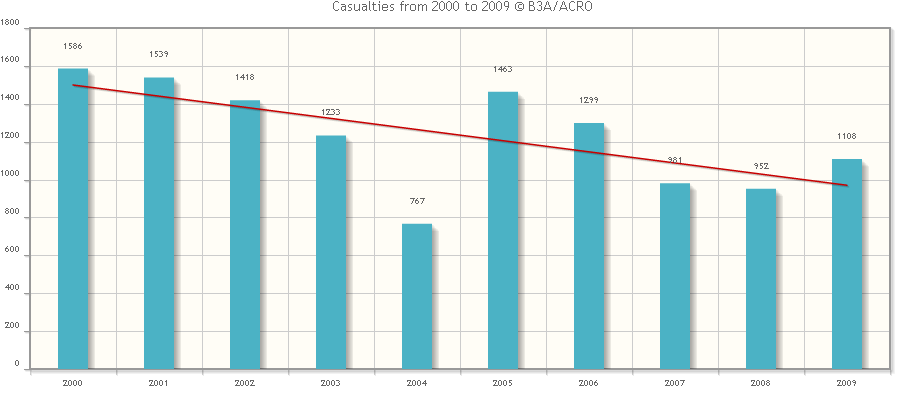
Air Crash Casualties 2010-2014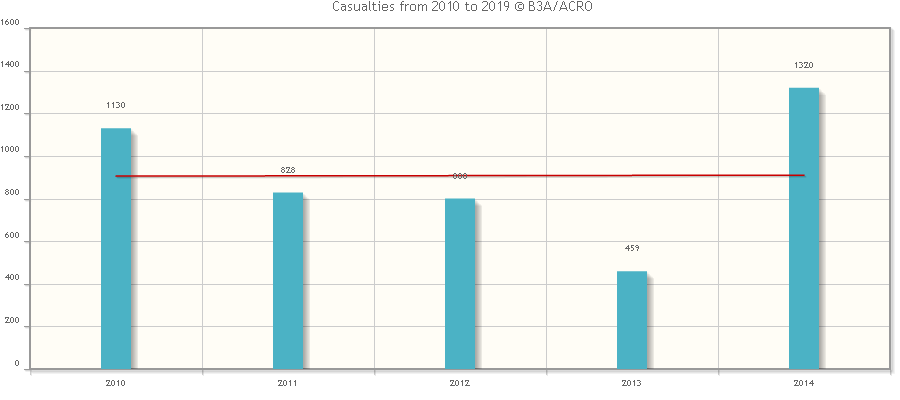
The worst year of all time for flight-related fatalities was 1972 with 3,346, followed by 1944 with 3,171 (that includes all the world's air forces, just to give you some perspective on how bad 1972 must have been). 1989, the year my faith in flying was irreparably shaken, comes in at number nine.
7. Visual Map of the Sciences by Wired
8. The Oatmeal explains Net Neutrality
Matthew Inman, aka the guy who draws The Oatmeal, has a wonderful grasp of the absurd and a freewheeling, unrepentant flair for concocting the most innovative streams of profanity. But I think he's at his very best when he wields his indignation like one of those medieval spiky-balls on a chain in support of his activism, like he does in this post that perfectly explains why Net Neutrality is an important, and for those who care, nonpartisan issue—it's aimed at Ted Cruz but instructive for everybody. (See also: Last Week Tonight with John Oliver: Net Neutrality)
Inman also had a great year in 2014, drawing the attention of CEO and sex symbol-in-chief of Tesla Motors, Elon Musk by closing a rave review of his new Tesla Model S by boldly hitting up the billionaire entepreneur for $1.37 million. (The amount needed to purchase Nikola Tesla's old laboratory and turn it into a museum honoring the slighted genius.) Elon Musk responded to The Oatmeal's Hail Mary request with an offer of $1 million and encouragement to raise the remaining funds from The Oatmeal's now very much onboard fan base. Have you told the Internet today how much you love it?
2014 Year in Review: Some of the Best Articles of All Time
An incomplete list in no particular order.
1. In the Realm of the Unabomber by Gary Greenberg, McSweeney's Quarterly, 1999 (Read parts I, II, III, VI, XIV at McSweeneys.net.)
Excerpt:
"The first time I got a letter from the Unabomber, I had my wife open it.
I was at work, the letter had come to my house, and neither of us wanted to wait to see what Ted Kaczynski, whose outgoing mail was by then inspected by the United States Bureau of Prisons, had to say. Sealed in a #10 envelope, the letter was addressed in the careful block capitals that the post office says will guarantee maximum efficiency. He even put his return address, in the same frank print, in just the right spot. No fool, Kaczynski knows that the mails will only work for you if you work with them."
2. Junkspace by Rem Koolhaas, 2001
Excerpt:
"Junkspace is overripe and undernourishing at the same time, a colossal security blanket that covers the earth in a stranglehold of seduction... Junkspace is like being condemned to a perpetual Jacuzzi with millions of your best friends... A fuzzy empire of blur, it fuses high and low, public and private, straight and bent, bloated and starved to offer a seamless patchwork of the permanently disjointed. Seemingly an apotheosis, spatially grandiose, the effect of its richness is a terminal hollowness, a vicious parody of ambition that systematically erodes the credibility of building, possibly forever..."
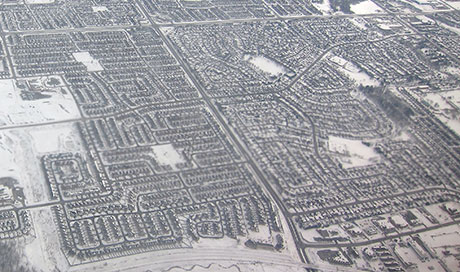
3. The Simpsons Generation by Chris Turner, Shift Magazine, 2002 (Sadly, not available online..)
Excerpt:
"We will never know just how great an opportunity was lost, how much passionate momentum squandered. Here were the people of virtually the entire world—and certainly the entire First World—rising as one, ready to sacrifice, wanting to help. Who knows how many oversights could have been corrected, inequalities eliminated, hypocrisies inverted? Who knows what glorious civilization could have emerged from the ashes of those towers? One thing is for certain: Our leaders didn't, and don't. They have failed us completely in this regard—particularly those of the United States of America, that self-proclaimed last best hope for humanity. America's primacy of place and supremacy of power in world affairs, be they economic, political, military or cultural, has never been more apparent than in the wake of September 11, when, as if in some half-witted Hollywood movie, the whole world looked to America for direction. And was told to go shopping."
4. Ah, Wilderness! by Art Linson, Vanity Fair, April 2002
Excerpt:
"First, we received the obligatory and expected turndown from Harrison Ford. At that time, any script that required a male lead over 45 went directly to Harrison... It didn't matter if the character was an international spy or a transvestite... Unless, of course, Tom Cruise was interested. Cruise would've been allowed to play the bear in our script, or any other role of his choosing... If several actors or directors pass, their enthusiasm goes on life support... and eventually, as the rejections add up, finger-pointing inevitably follows. "Who the fuck on my staff liked this piece-of-shit script anyhow?" "Can you believe even Richard Gere thought it was bad?"
5. The Acid King by Peter Wilkinson (Rolling Stone, July 5, 2001)
Excerpt:
"In some ways, the story of Leonard Pickard and Todd Skinner is a story about the collision of Sixties idealism with the materialism and pragmatism of the nineties—Timothy Leary's America versus Bill Clinton's, if you will. And its moral will be clear even before the Judge calls the court to order; the sweet but easily corruptible dream of the flower-power generation never really stood a chance—but it was fun while it lasted."
6. The Lilly Suicides by Richard DeGrandpre, 1999
Excerpt:
"The rate of depression in the 1950s was estimated at about 50 people per million, an estimate that would grow to 100,000 per million by the end of the century. This is a 2,000-fold increase in what is ostensibly a hereditary disease. What happened during these years is not that a disease was discovered, or its cure. What happened is that, because of ongoing changes in the drug marketplace, the pharmaceutical industry began to take an interest in depression."
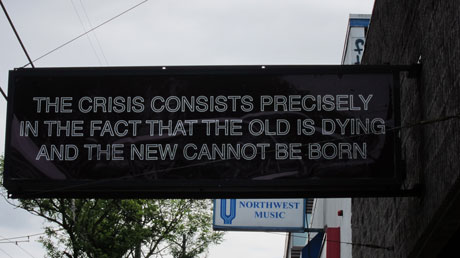
7. An Open Letter to My Sister, Miss Angela Davis by James Baldwin, November 19, 1970
Excerpt:
"Dear Sister:
One might have hoped that, by this hour, the very sight of chains on black flesh, or the very sight of chains, would be so intolerable a sight for the American people, and so unbearable a memory, that they would themselves spontaneously rise up and strike off the manacles. But, no, they appear to glory in their chains; now, more than ever, they appear to measure their safety in chains and corpses. And so, Newsweek, civilized defender of the indefensible, attempts to drown you in a sea of crocodile tears ('it remained to be seen what sort of personal liberation she had achieved') and puts you on its cover, chained..."
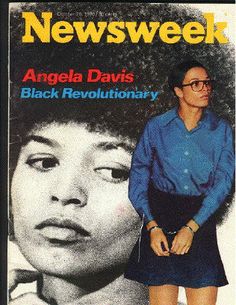
Beautifully poignant and brutally candid, this letter sums up much of what was and still is, 44 years later, tragically wrong with race relations in America. It is also an interesting counterpoint to an essay published earlier the same year, Radical Chic and Leonard Bernstein's Party for the Black Panthers. Unfortunately, despite the zesty retro bite of passages like the one below, Tom Wolfe's article reads to the modern mind like a whiter shade of Lenny Bruce's "How To Relax Your Colored Friends at Parties."
Excerpt from Radical Chic by Tom Wolfe, Jun 8, 1970:
"Christ, if the Panthers don't know how to get it all together, as they say, the tight pants, the tight black turtlenecks, the leather coats, Cuban shades, Afros. But real Afros, not the ones that have been shaped and trimmed like a topiary hedge and sprayed until they have a sheen like acrylic wall-to-wall—but like funky, natural, scraggly. . . wild . . .
These are no civil-rights Negroes wearing gray suits three sizes too big—
—no more interminable Urban League banquets in hotel ballrooms where they try to alternate the blacks and whites around the tables as if they were stringing Arapaho beads—
—these are real men! Shootouts, revolutions, pictures in Life magazine of policemen grabbing Black Panthers like they were Viet Cong—somehow it all runs together in the head with the whole thing of how beautiful they are. Sharp as a blade. The Panther women—there are three or four of them on hand, wives of the Panther 21 defendants, and they are so lean, so lithe, as they say, with tight pants and Yoruba-style headdresses, almost like turbans, as if they'd stepped out of the pages of Vogue, although no doubt Vogue got it from them."
While we're on the topic, here's another relevant tidbit from Jet magazine, 1970:

8. Total Eclipse by Annie Dillard
I honestly think this might be the best article I've ever read.
Excerpt:
"This was the universe about which we have read so much and never before felt: the universe as a clockwork of loose spheres flung at stupefying, unauthorized speeds. How could anything moving so fast not crash, not veer from its orbit amok like a car out of control on a turn?"
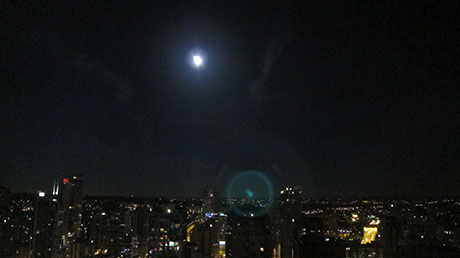
2014 Year in Pictures
1. This is the picture of the year. Un fucking fortunately. (Stephen Lam/Reuters)
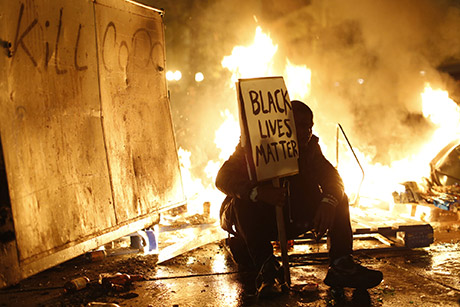
Hey, America... Don't you ever get tired of making excuses while the world is watching your streets burn? While your classrooms are riddled with bullets? While your citizens comfort the mothers of slain teenagers and rinse tear gas from their eyes? Does it bother you when Cuba makes fun of your shitty health care system, when China criticizes your environmental policies or Germany—Germany!—is shocked and offended by your human rights violations? Hold on—South Africa is on the line... yeah, they're disgusted at your treatment of black people.
2. Greenland's black ice problem. (photographed by Jason Box)

3. Aerial photo of Oso River in Washington State after the mud slide that killed 43 people on March 22. (BBC)
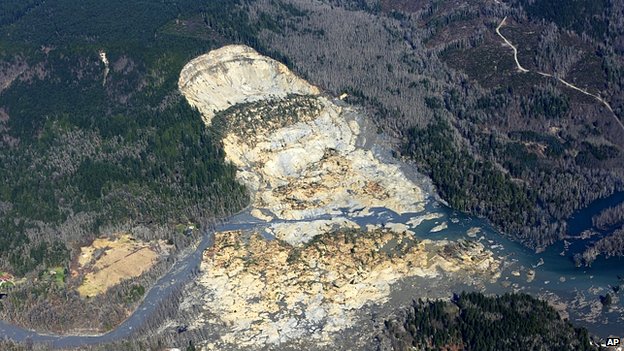
4. The San Andreas Fault photographed in a pensive moment. (BBC)
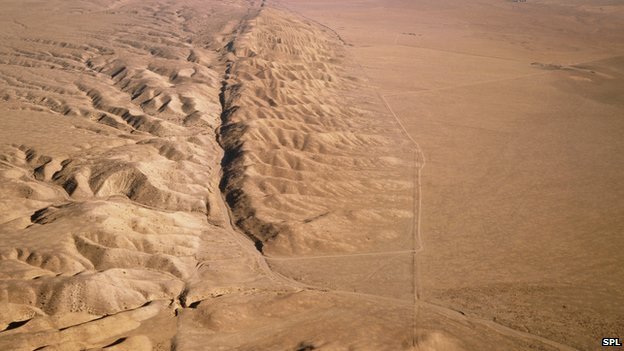
5. "Protests" in Kiev look more like deleted scenes from "Days of Future Past"—if they were shot on location in the Middle Ages during the Crusades and an outbreak of the Black Plague.
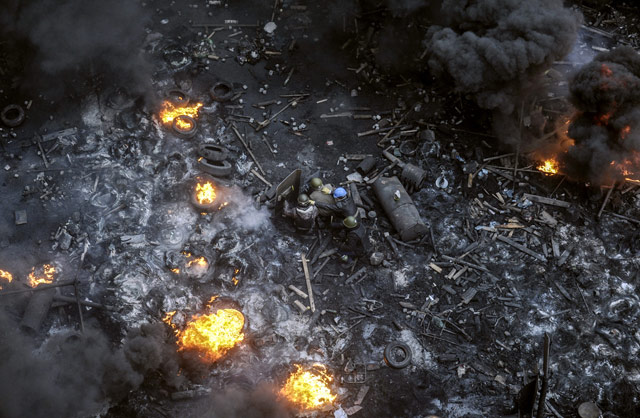
6. Japan is sorry. :( America, why can't you be more like Japan?

7. Chernobyl control center photographed in 2014 (Ukraine is sorry, too). (Reuters)
8. ...but Japan also has the Super-Kamiokande neutrino observatory. (Andreas Gursky)

9. Typhoon survivors in The Philippines photographed by Philippe Lopez. (Getty Images)

10. The Guardian staff members destroy hard drives containing copies of Edward Snowden's files, which they were ordered to turn over to the government. Instead they took power tools to them and let the cameras roll.

Best Movies & Documentaries
- Interstellar
- X-Men: Days of Future Past
- Seeking a Friend for the End of the World
- American Hustle
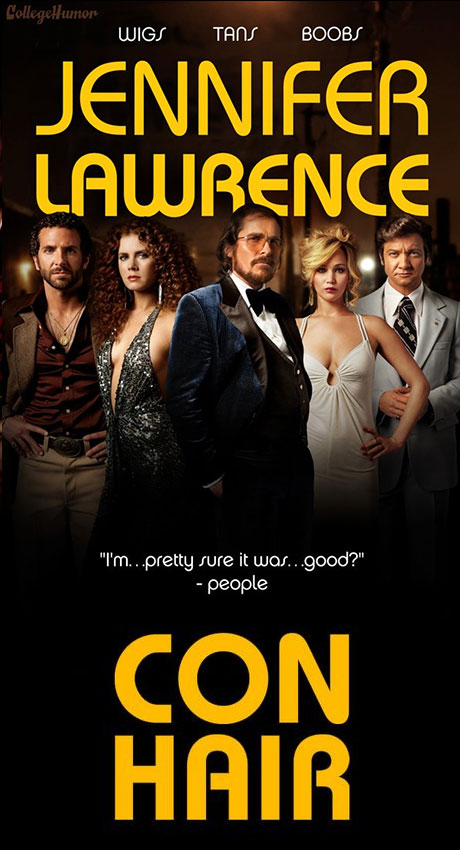
["Honest movie poster" mashup components by College Humor and the Shiznit]
- Star Trek: Into Darkness
- The Sinking of Japan
At the very least, watch Part 1 on YouTube. In the opening scene, we meet our three protagonists as the solid world begins to slip from beneath their feet. First, we spot the adorable orphan, a mop of ruined pigtails framing her face as she wanders disheveled and shell-shocked through a waking nightmare. A man opens his eyes and finds himself trapped in a pile of twisted metal that was recently his car. The camera zooms in on his elegant profile, his skin aglow in the orange light of the burning wreckage around him. He struggles to free himself and finally emerges... into chaos—buildings reducing themselves to rubble, downed power lines dangling like live cobras, and everywhere—fire. He spots the girl a few car-lengths away, wandering oblivious into the crosshairs of a collapsing utility pole dragging a comet's tail of flaming debris behind it. Before he can reach her, a helicopter materializes out of the smoking sky. Swinging on a cable beneath, a harnessed figure in flame-retardant armor rides the shockwave of billowing fire and swoops down into the street, just in time to seize the bewildered girl and knock the man to safety. Another massive explosion engulfs the spot where they had been standing. Safe for the moment, the rescuer removes her mask and the three stand together surrounded by collapsing storefronts as a nearby volcano spews liquid fire high into the black sky.
Six minutes into The Sinking of Japan, the movie lays down the scientific bedrock on which our disbelief will be suspended. The imminent collapse of the island nation is explained in less than a minute using infographics as clear as a stop sign and as pedestrian as PowerPoint. It's such a concise and perfectly comprehensible presentation that every disaster movie hereafter should take a cue. With that out of the way, "The Sinking of Japan" can do just about anything* it wants for the next two hours because, damn it, we believe.
(*Except... The Sinking of Japan makes one glaring detour from the path of disaster movie righteousness, when a tearful reunion right before the climactic finale is accompanied by a full-length, full volume Japanese equivalent of a Celine Dion love theme. It brings the action to a screeching, four-minute halt and takes the audience's credulity with it. I don't know if audiences in Japan are more accepting of this sort of thing than we are in North America but, speaking for myself, it was damn near unacceptable.) - Veronica Mars
- The Secret Life of Walter Mitty
- Jodorowsky's Dune
- The Wolf of Wall Street
Honestly, I can't decide if this movie is an over-cranked Goodfellas remake with a throwback-to-Wall Street "moral of the story" tacked on during the credits, albeit one featuring a handful of memorable scenes and enjoyable performances and cameos or, if my well-educated communist friend is to be believed, it's a cleverly crafted cautionary tale for would-be Wall Street douche bags. They who can't be bothered to read Noam Chomsky or tune in to the four minutes of Chomsky included in any youtube documentary on politics or the economy made in the last 15 years, whose "medicine" therefore must be buried deep beneath a thick coating of intoxicating, sugary, mind-numbing excess. The chief advantage my friend's argument offers is that it allows you to conclude that the film's apparent failings are not the fault of its legendary director (whose efforts we are understandably loath to denigrate), but rather our own because, after all, we are not "the average viewer." As tempting as it might be to imagine one's self the rare Chomsky reader in an audience filled with wanna-be Gordon Gekkos; if I'm barely capable of decoding a hidden message of empathy and economic equality in the three-hour bacchanalia of dwarf-tossing, naked hookers, masturbation, misanthropy and screaming, drug-fueled freakouts, I think my friend may be giving the douche bags a little too much credit.
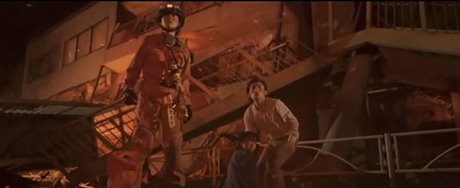
Best Videos of 2014 (in no particular order)
2. Washington Square — The Correspondents
3. Demonstrators "disrupt" STL symphony singing a Requiem for Mike Brown
4. Animal Consciousness Officially Recognized by Leading Panel of Neuroscientists
5. Dinner For Five (all five seasons)
6. Last Week Tonight with John Oliver: Miss America Pageant (HBO) (if I had to pick just one)
7. Razzle Dazzle: Fame Through Movies: The Takeaway from Steven Santos on Vimeo.
8. The Singularity — feat. Ray Kurzweil & Alex Jones [RAP NEWS 28]
9. The Speakeasy Three — When I Get Low, I Get High
10. Building Bridges in Astrology by Kelly Lee Phipps
11. If Google was a Guy by College Humor (parts 2 & 3 are good too)
12. Danger: Humans by Tom Scott (who you may remember from last year's Welcome to Life: the singularity, ruined by lawyers).
Top 5 Games Played (or Heard About) in 2014
(What—you really think I could come up with 10?)
5. Circa 1948
This historical art game developed for the iPad and iPhone is available free on iTunes and it looks so awesome it almost makes me want to go out and borrow one.
iTunes Description: "The first Real-time 3D art app to tell a story inspired by real events. An immersive experience created by internationally renowned artist Stan Douglas and the award-winning NFB Digital Studio. Through photorealistic 3D illustrations rendered from Douglas' extensive historical research, Circa 1948 takes users to the late 1940s, Vancouver, BC, a young city in the midst of urban planning, but divided along lines of race and income."
4. Amy
This game appeared as a download on Xbox Live shortly after The Walking Dead Season 4 finale aired. Coincidence? Zombie-deprived fans who took the bait were soon joining the legions of gamers who paid actual money for this game the year before. The absolute, across-the-board hatred garnered by this game is truly impressive and, with an average of 1.25 out of 5 stars, its reviews are peppered with invectives like pathetic, infuriating, shoddy and incoherent. You're not likely to see another game described with such colorfully excoriating phrases as "unapologetically loathsome" and "an infinity of soul-crushing distress."
(Ha, good one.) But I did play a few rounds before becoming extremely annoyed about all the aforementioned shortcomings, and then I sat back and watched Mr. Pink get annoyed, swear at the screen and take month-long breaks before eventually beating the damn thing, all for an unforgivably lame, hastily slapped-together "cut scene" (that looked more like a montage of blurry, confusing still frames) which failed on all levels, to either extrapolate on the plot at hand, wrap up the story of the current game or muster up sufficient intrigue to suggest a sequel. But it's just as well—with reviews like these, it would take a miracle to get an Amy 2.0 greenlit.
3. Remote Associates Test of Creativity
It doesn't get much more low-tech than this. The RAT gives you combinations of three words (e.g., trap, polar, claw) and you have to figure out the word that connects them (e.g., bear). Developed in 1962, this test may or may not predict creativity, but it's fun as hell and diabolically addictive—and there are 315 of them. I powered through the first half before purposely getting Mr. Pink hooked in the hopes he'd be able to figure out some of the more confounding combinations (which he did, even more impressively than I'd hoped!). We're still chipping away at the the last 20.
2. Grand Theft Auto V
It's not just the best and fastest selling game of all time, it's "the fastest-selling entertainment product in history, earning US $800 million in its first day and US $1 billion in its first three days," according to Wikipedia. Here's what the The Guardian says about the UK's biggest export since The Beatles:
"Grand Theft Auto is less a video game franchise, more an interactive cultural barometer. Set in the US but born in Britain, its evolution over the past two decades from a scrappy, pixelated love letter to crime cinema into a fully explorable, high-definition, living, breathing, society-satirising personal playground has created a medium all of its own."
1. Telltale Games' The Walking Dead: Season 2
We played the first "season" of this game early in 2012, before we'd even watched the TV show. Two years, 4.5 seasons and 22 graphic novels later, we are well and truly hooked on the show, the book, the game and at least two podcasts... So when the second "season" of the game came out on Xbox Live, we played the five installments as they came out—not only because who wants to wait, but because it's getting to the point where you can't let a couple of days go by without someone spoiling major plot developments (and I'm not just talking about my Mother either!).
The first season of the game <spoiler alert> was so heart-wrenchingly successful in forging an emotional attachment between gamers and the (doomed) characters that we experienced genuine trauma when they (inevitably) perished. Two years later, it's no surprise that quotes like these are more the rule than the exception on the season 2 discussion board:
- "So fucking mad at Telltale Games for the decisions that had to be made today." — Nina
- "That ending was so intense for me I seriously cried for like 5 minutes straight, as I watched these events unfold." — Viktor
- "Goddamn I'm so broken right now, I need me some of that rum." — Ollie
- "It's been a few days already, but I still either think about whether I did the right thing, or cry about what happened." — Tonya
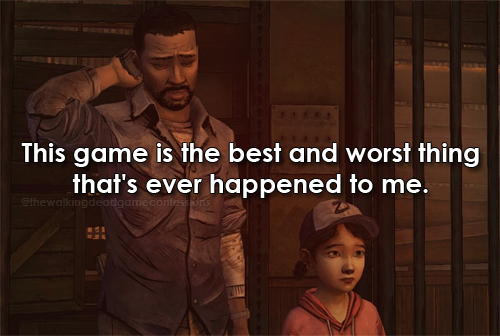
From TheWalkingDeadGameConfessions.Tumblr.com.
